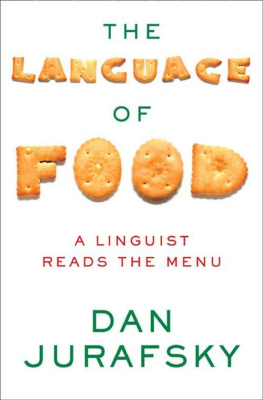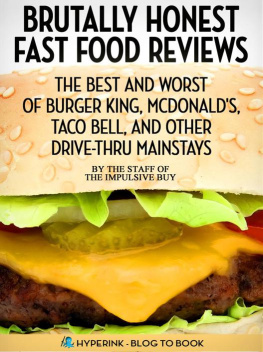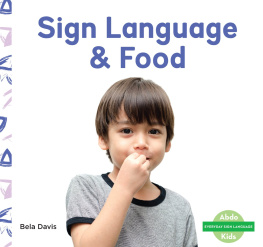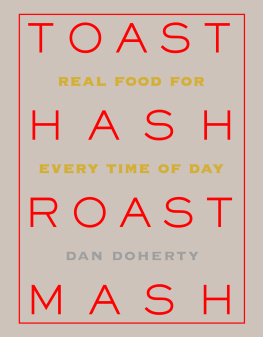THE
LANGUAGE
OF FOOD
A Linguist Reads the Menu
Dan Jurafsky

W. W. NORTON & COMPANY
New York London
For Janet
Contents
THE LANGUAGE
OF FOOD
THIS BOOK BEGAN WITH two questions. The first came from Katie, the very observant seven-year-old daughter of my old friends Jim and Linda. Katie asked why the label of a ketchup bottle read tomato ketchup. (Go look: most of them do.) Isnt that redundant, she asked? It was a sensible question. After all, if I go into a bar and order a margarita, I dont order a tequila margarita. A margarita is made of tequila. (Otherwise, it would be a daiquiri. Or a gimlet. Or even, God forbid, a cosmopolitan.) The tequila is understood.
So why do we mention the tomatoes in ketchup?
The second question came from Shirley, a friend from Hong Kong. Back when I was a young linguist studying Cantonese there, everyone assured me that the word ketchup came from Chinesethe second part of ketchup, tchup , is identical to the word for sauce in Cantonese, and the first part, ke, is part of the Cantonese word for tomato. Shirley was so convinced that ketchup was a Chinese word that when she went to a McDonalds in the United States she confused her friends by asking what the English word for ke-tchup was. But how could ketchup be Chinese?
It turns out Katies question and Shirleys question have the same answer. The ketchup we eat today is nothing like the original version created many centuries ago. Few people today would recognize the link with the original ke-tchup , a Chinese fermented fish sauce first made in Fujian province (an area that also gave us the word tea ). From the fourteenth to the eighteenth centuries, Chinese traders settled in ports throughout Southeast Asia and brought Chinese fermentation methods. They fermented local fish into ke-tchupa fish sauce like the modern Vietnamese fish sauce nuoc mam they fermented soybeans into soy sauce, and they fermented rice with a red ferment, molasses, and palm sugar and distilled it into an ancestor of rum called arrack . Arrack was the first widely produced liquor, long before rum or gin had been invented, so when English and Dutch sailors and merchants came to Asia around 1650 to trade for silk, porcelain, and tea, they bought vast quantities of arrack and used it to invent the worlds first cocktail (punch) for their navies. (And punch led eventually to modern cocktails like daiquiris and gimlets and margaritas.). Along the way, they also acquired a taste for the pungent fish sauce.
The traders brought ke-tchup back to Europe and over the next 400 years this dish evolved to fit Western tastes, losing its original ingredient, the fermented fish. Early recipes replaced the fish with English mushroom or, as in Jane Austens household, walnuts. By the nineteenth century in England, there were many recipes for ketchup; eventually the most popular one added tomatoes and then came to America where it acquired sugar. Then it acquired even more sugar. This version eventually became Americas national condiment, and was then exported to Hong Kong and the rest of the world.
The story of ketchup is a fascinating window onto the great meetings of East and West that created foods we eat every day, telling us how sailors and merchants spent a thousand years melding the food preferences of the West and the East to form our modern cuisines. But this great process produced more than just ketchup, as we can tell from linguistic evidence scattered through modern languages. Fish and chips, Englands national dish, began with Persian sikb  j , a sweet-and-sour stew with vinegar and onions loved by the Shahs of sixth-century Persia. The dish leaves its marks in the names descended from sikb
j , a sweet-and-sour stew with vinegar and onions loved by the Shahs of sixth-century Persia. The dish leaves its marks in the names descended from sikb  j in different languagesFrench dishes like aspic , Spanish dishes like escabeche , or Peruvian dishes like ceviche and the story moves from the golden palaces of medieval Baghdad to the wooden ships of Mediterranean sailors, from the religious fasts of medieval Christians to the cold Sabbath fish of the Jews who left Spain in 1492.
j in different languagesFrench dishes like aspic , Spanish dishes like escabeche , or Peruvian dishes like ceviche and the story moves from the golden palaces of medieval Baghdad to the wooden ships of Mediterranean sailors, from the religious fasts of medieval Christians to the cold Sabbath fish of the Jews who left Spain in 1492.
Macaroons , macarons , and macaroni all descend from one sweet doughy predecessor, when a Persian food, the almond pastry called lauz  naj , intermingled with the pastas of the Arab world and the durum wheat that the Romans had planted in Sicily, the breadbasket of the Roman Empire.
naj , intermingled with the pastas of the Arab world and the durum wheat that the Romans had planted in Sicily, the breadbasket of the Roman Empire.
Well look at the answers to questions of science, politics, and culture. Who came up with the idea of putting cream or juice into a bucket surrounded by salt and ice to make sorbet or ice cream , and how does it relate to the patent medicinal syrups that became our modern Cokes and Pepsis? The answers lie in the adventures of the words sherbet , sorbet , and syrup , and their descent from an Arabic word meaning drink or syrup.
Why is the turkey , a bird native to Mexico, named for a Muslim democracy of the eastern Mediterranean? It has to do with the fanatic secrecy of the Portuguese in the fifteenth and sixteenth centuries, whose attempt to keep other countries from finding their overseas sources of gold and spices and exotic birds led to the confusion of the turkey with an entirely different bird that was imported by the Mamluks.
Why do we give toasts at weddings? It is not related to the custom of toaster ovens as wedding presents, but the two do share a surprising history involving toasted bread.
Why do we fancy something sweet at the end of a mealso much so that we have influenced Chinese restaurants in the United States to offer one when their own culture didnt even have a word for dessert, let alone a fortune cookie? Well see the history of dessert (rooted in Andalusia, Baghdad, and Persia), and well introduce the grammar of cuisine, the idea that eating sweets at the end of a meal (rather than, say, the beginning) is rooted in the implicit structures that define each modern cuisine in the same way grammar rules help define a language.
The language of food helps us understand the interconnectedness of civilizations and the vast globalization that happened, not recently, as we might think, but centuries or millennia ago, all brought together by the most basic human pursuit: finding something good to eat. You might call this aspect of the book EATymology. But the language of food isnt just an etymological clue to the past. The words we use to talk about food are also a code that we can decipher to better understand the present.
In our lab at Stanford, we use linguistic tools to study online or digital texts of all kinds, with the goal of better understanding the human condition. Weve studied recordings of , and show that, sadly, the more power and status people achieve, the less polite they become.
Throughout this book Ill apply these computational linguistic tools to the study of food, drawing on rich datasets now available due to the rise of the Internet and examining millions of online restaurant reviews, thousands of online menus, the linguistics of food advertising and food brands.
Ill use these tools and others from the intersection of linguistics and economics to uncover subtle linguistic cues hidden in the language of todays food advertisers, showing surprising ways that you are being targeted every time you read a menu or even look at the text on the back of a package of potato chips. You will even see how linguistic cues can predict the price of individual dishes on a menu, based not only on the words that appear but also on those purposely omitted.
The language of food also tells us about human psychology, who we are, from the nature of our perception and emotions to the social psychology of our attitudes toward others. By using software to investigate millions of online reviews of restaurants or beers, we discover evidence for the Pollyanna effect: a claim from psychology that human nature strongly tends toward the positive and optimistic. Hence our comparisons of good food to, say, sexual pleasure. Well also look at how people talk about restaurants they really hate, the scathing 1-star reviews, discovering what people are most traumatized by, and well see that its all about our connection to others.
Next page









 j , a sweet-and-sour stew with vinegar and onions loved by the Shahs of sixth-century Persia. The dish leaves its marks in the names descended from sikb
j , a sweet-and-sour stew with vinegar and onions loved by the Shahs of sixth-century Persia. The dish leaves its marks in the names descended from sikb  naj , intermingled with the pastas of the Arab world and the durum wheat that the Romans had planted in Sicily, the breadbasket of the Roman Empire.
naj , intermingled with the pastas of the Arab world and the durum wheat that the Romans had planted in Sicily, the breadbasket of the Roman Empire.